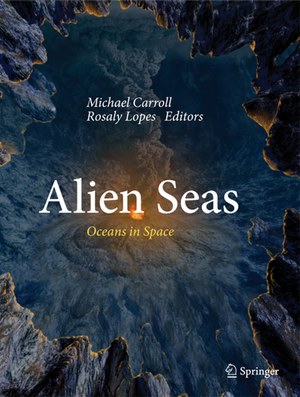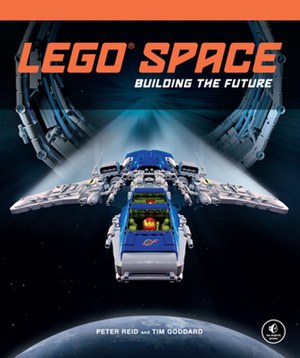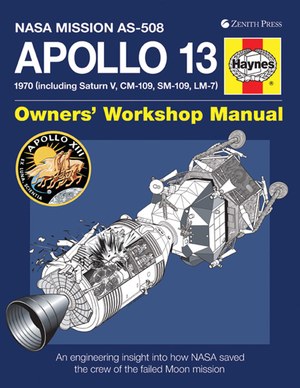|
|
Reviews: creative approaches to space books
by Jeff Foust
Monday, December 9, 2013

Apollo 13 Owners’ Workshop Manual
by David Baker
Zenith Press, 2013
hardcover, 204 pp., illus.
ISBN 978-0-7603-4619-8
US$28
Alien Seas: Oceans in Space
by Michael Carroll and Rosaly Lopes (eds.)
Springer, 2013
hardcover, 130 pp., illus.
ISBN 978-1-4614-7472-2
US$29.99
LEGO Space: Building the Future
by Peter Reid and Tim Goddard
No Starch Press, 2013
hardcover, 216 pp., illus.
ISBN 978-1-59327-521-1
US$24.95
There are, even within the narrow niche of space-related books, some familiar sub-genres, like science books, historical accounts, and astronaut memoirs, that share the same basic approach and structure. Yet, there is, within the confines of those familiar formats, room for some creativity. Three new books demonstrate how that can be done.
The cover of Apollo 13 Owners’ Workshop Manual may give the reader a double take. It’s patterned on the series of automotive repair manuals published by Haynes, only this time the illustration of a car is replaced with that of an Apollo spacecraft—one with an explosion erupting from the Service Module, as happened to Apollo 13 en route to the Moon in April 1970. If any space mission needed a repair manual, it was Apollo 13.
| If any space mission needed a repair manual, it was Apollo 13. |
While the cover might give the appearance of a classic repair manual, the contents are rather different. David Baker worked at the then-named Manned Spacecraft Center—now Johnson Space Center—during the mission, and even mentions in the book Chris Kraft running into him as Kraft hurried back to mission control after a press conference a few hours after the explosion. Baker provides a chronology of the mission, rich in technical detail, from before the launch through the landing, accompanied by many diagrams of vehicle systems and related documents. That level of detail is probably too much of the casual reader, but space aficionados already familiar with Apollo 13 will likely appreciate this technical tick-tock of the mission that Baker provides.
 |
A first glance through the contents of Alien Seas gives the impression of a familiar formula for a science book: a collection of essays on a topic, in this case the presence of oceans—of water or other substances—on worlds in our solar system and beyond. Planetary scientists examine the oceans that likely formerly existed on Mars, the subsurface water oceans on Europa and other icy moons in the outer solar system, and the hydrocarbon lakes and seas of Titan. The scope of the book even goes beyond relatively conventional fluids to include the seas of molten rocks found on terrestrial worlds in early in their histories, and the “sand seas” in the deserts of Earth and on parts of Titan and Mars.
What sets this book apart from other planetary science accounts? One is the choice of the author of the book’s foreword: director and explorer James Cameron, who has plumbed the depths of the Earth’s oceans and dreams of doing the same on other worlds: “Men and women, their breath catching in their throats at the enormity of where they are standing and what they are seeing, must go to these alien shores and push back the boundaries of the unknown.” The other, and perhaps more valuable, factor distinguishing this book is the original art by Michael Carroll and other artists that help illustrate these extraterrestrials oceans. A number of chapters include artwork by Carroll, and a final chapter features a “gallery of maritime planetscapes” by various artists, offering their own visions of past, present, and potential oceans on worlds in our solar system and on exoplanets. This artwork helps the reader visualize the exotic seas that may exist beyond Earth.
 |
LEGO Space, by contrast, has few ties to science or space history, but is an entertaining read. The authors use the classic building blocks to create a future history of spaceflight, complete with a menagerie of spacecraft, space stations, robotic, and more, all built with LEGO pieces. A sci-fi story of alien contact and conflict move the book along; it’s a basic story, but one that’s fun to follow simply to see the creativity the authors demonstrate in crafting intricate spacecraft from off-the-shelf LEGO parts.
| “Men and women, their breath catching in their throats at the enormity of where they are standing and what they are seeing, must go to these alien shores and push back the boundaries of the unknown,” writes Cameron. |
There’s likely a significant overlap between space fans and LEGO enthusiasts, demonstrated in recent years by the selection of fan-developed LEGO models of Japan’s Hayabusa spacecraft and NASA’s Curiosity rover for sale through LEGO’s CUUSOO program (an “Exo Suit” created by one of the authors, Peter Reid, and included in the book has also been chosen for production.) This books will probably be fascinating for those people, but maybe a little frustrating too for those who want to build their own: the authors provide instructions for a few of the many LEGO models included in the book, but not all. Perhaps, though, it will provide some inspiration for more space-themed LEGO models.
Jeff Foust (jeff@thespacereview.com) is the editor and publisher of The Space Review. He also operates the Spacetoday.net web site and the Space Politics and NewSpace Journal weblogs. Views and opinions expressed in this article are those of the author alone, and do not represent the official positions of any organization or company, including the Futron Corporation, the author’s employer.
|
|


